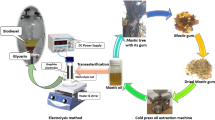Abstract
When used as a biodiesel fuel, isopropyl esters are expensive compared to the more common methyl esters. However, isopropyl esters have better cold flow properties than methyl esters, allowing the use of highly saturated feedstocks such as tallow or lard. It has not been determined if isopropyl esters can be part of an economical biodiesel (B100) blend for a specified cloud point, which allows for an objective material cost comparison. This work explores this question through the use of an empirical cloud point model that has been developed and validated. Constrained cost minimization was performed using the cloud point model and historical prices for alcohols and triglycerides. Case studies using 2003 and 2006 average prices are presented. The results indicate that an expensive component such as isopropyl ester can be part of an economical blend under the market conditions. For isopropyl esters to be feasible as an economical blend component, they have to be derived from a highly saturated feedstock that is less expensive than soybean oil by $0.10/lb. This price differential is most applicable to a biodiesel blend that has a cloud point between 5 and 10 °C.









Similar content being viewed by others
References
Knothe G (2005) Dependence of biodiesel fuel properties on the structure of fatty acid alkyl esters. Fuel Proc Technol 86:1059–1070
Ash M, Dohlman E (2007) Oil crops outlook: 2007. OCS-07j. USDA ERS, Washington, DC
Haas MJ, McAloon AJ, Yee WC, Foglia TA (2006) A process model to estimate biodiesel production costs. Bioresour Technol 97:671–678
Wang PS, Tat ME, Van Gerpen J (2005) The production of isopropyl esters and their use as a diesel engine fuel. J Am Oil Chem Soc 82:845–849
Lee I, Johnson LA, Hammond EG (1995) Use of branched-chain esters to reduce the crystallization temperature of biodiesel. J Am Oil Chem Soc 72:1155–1160
Nelson LA, Foglia TA, Marmer WN (1996) Lipase-catalyzed production of biodiesel. J Am Oil Chem Soc 73:1191–1195
Wu WH, Foglia TA, Marmer WN, Dunn RO, Goering CE, Briggs TE (1998) Low-temperature property and engine performance evaluation of ethyl and isopropyl esters of tallow and grease. J Am Oil Chem Soc 75:1173–1178
American Society for Testing Materials (2005) ASTM D2500-05. American Society for Testing Materials, Philadelphia
Dunn RO, Bagby MO (1005) Low-temperature properties of triglyceride-based diesel fuels: transesterified methyl esters and petroleum middle distillate/ester blends. J Am Oil Chem Soc 72(8):895–904
Scheffe H (1963) The simplex-centroid design for experiments with mixtures. J R Stat Soc B 25:235–263
Petersen LJ, Van Gerpen JH (2006) High yield biodiesel fuel preparation process. U.S. Patent application 2006/0021277
Chemical Market Reporter (2007) Indicative chemical prices A–Z. Reed Business Information Limited, Sutton. http://www.icis.com
USDA (2007) Oil crops yearbook data table 1980–2006. USDA Economic Research Service, Washington, DC. http://www.ers.usda.gov
Wang PS (2007) Isopropyl esters as solutions to current biodiesel challenges. PhD dissertation, University of Idaho 83–118
Chemical Market Reporter (2005) Methanol profile. Chem Mark Rep 268(11):42
Chemical Market Reporter (2005) Isopropanol profile. Chem Mark Rep 267(1):27
Schrijver A (1998) Theory of linear and integer programming. Wiley, Chichester
Author information
Authors and Affiliations
Corresponding author
About this article
Cite this article
Wang, P.S., Thompson, J. & Van Gerpen, J. Minimizing the Cost of Biodiesel Blends for Specified Cloud Points. J Am Oil Chem Soc 88, 563–572 (2011). https://doi.org/10.1007/s11746-010-1691-x
Received:
Revised:
Accepted:
Published:
Issue Date:
DOI: https://doi.org/10.1007/s11746-010-1691-x




